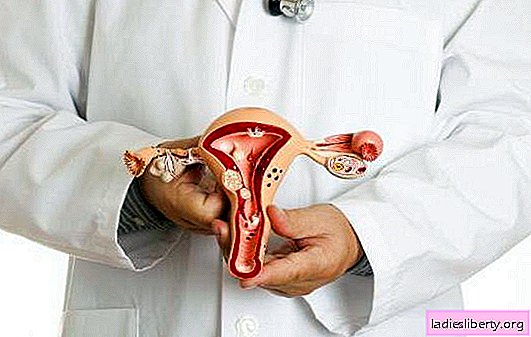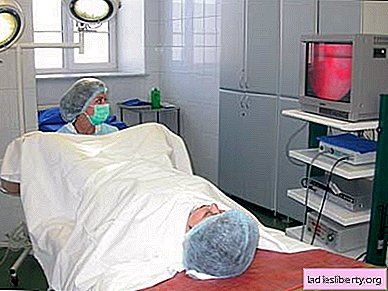
Pathologies of female organs are a serious problem.
Endometritis is a serious disease in women, in which the inner mucous membrane of the uterus is very inflamed.
This shell is extremely important for the normal functioning of the whole organism, since its growth and rejection form the basis of the entire menstruation process. Consider in more detail the symptoms of endometritis in women and methods of treating this ailment.
Endometritis in women: causes
By the nature of the course, acute and chronic endometritis is distinguished. Each of them develops for its own reasons.
The following factors can contribute to the appearance of an acute form of endometritis in women:
1. Abortion, especially if it has been performed repeatedly.
2. Diagnostic curettage of the uterine cavity.
3. Carrying out complex intrauterine manipulations.
4. The accumulation of blood or blood clots in the uterus.
5. Removal of the placenta or the remains of the ovum.
Most often, acute endometritis develops after childbirth. It occurs in 5% of all cases of natural birth and in 30% after cesarean section.
Postpartum endometritis provokes hormonal changes in the body, a decrease in immunity, as well as infectious lesions by fungi, viruses, parasites and bacteria.
Moreover, the state of the nervous, immune and endocrine systems plays a very important role in the appearance of uterine inflammation in women, which quite often complicates the course of the disease.
The chronic form of endometritis develops as a direct result of untreated acute inflammation of the uterine cavity. An impetus for the appearance of such a condition can be:
1. Sexual contact during menstruation in women.
2. Trauma to the uterus or cervix.
3. Long-term use of the intrauterine device.
4. An acute shortage of vitamin A in the body, stress or chronic diseases, due to which the woman’s immune system has weakened greatly, which has made her more susceptible to the progression of fungi, bacteria or viruses in the uterine cavity.
5. Failure to comply with the basic rules of intimate hygiene.
6. The presence of chronic infectious processes in the reproductive system.
As medical practice shows, in more than 80% of all cases, chronic endometritis is observed in women of the reproductive period who have previously performed abortions or practice intrauterine contraception.
Moreover, the following factors increase the risk of developing endometritis:
1. Postpartum damage to the perineum (rupture of the cervix, vagina). In this case, the infection will be much easier to penetrate the uterine cavity.
2. Chemical damage to the uterine lining.
3. The practice of frequent douching.
4. The use of vaginal spermicides that violate the natural microflora of the vagina.
5. The use of vaginal tampons, especially not timely replacement thereof, leads to the formation of pathogenic microflora inside the vagina. This leads to inflammation.
Endometritis in women: symptoms and signs
The acute form of endometritis, as a rule, is detected already on the third day after the initial infection. In this condition, a woman can observe the following symptoms of the disease:
1. A sharp increase in body temperature.
2. The patient feels cramps and pains in the lower abdomen.
3. An unpleasant odor appears from the genital tract.
4. Painful urination and chills are characteristic.
5. Purulent discharge appears from the vaginal cavity. Sometimes they can also be mixed with blood.
6. Increased heart rate and general deterioration of the patient's well-being. In this condition, a woman may suffer from headache, sleep disturbances, weakness, increased sweating and malaise.
When the above symptoms appear, a woman needs to contact a gynecologist as soon as possible and not self-medicate, since in this case the inflammatory process can spread far from the primary location. This, in turn, threatens life-threatening complications.
It is important to know, that with extreme severity acute endometritis occurs in those patients who have intrauterine devices. In addition to soreness, such women can observe full bleeding.
Manifestations of the chronic form of endometritis largely depend on the duration of the disease, the degree of damage, as well as the features of structural disorders of the endometrium.
In most cases, chronic inflammation of the uterus provokes the development of the following symptoms:
1. Violation of the menstrual cycle. At the same time, menstruation itself can be plentiful or vice versa, pathologically meager. And in the first and second case, this is not the norm.
2. Periodic uterine bleeding.
3. Aching pain in the lower abdomen. Also, soreness can occur during sexual intercourse.
4. A gynecological examination reveals a small compaction of the uterus and its increase.
5. Pain during bowel movements.
6. Putrid odor from the genital tract.
Endometritis in women: treatment methods
Acute endometritis has the following treatment features:
1. A woman is shown treatment in a hospital setting and bed rest. Along with this, the patient must observe mental and physical peace.
2. After a series of studies, antibiotics are prescribed to suppress the activity of the pathogen of inflammation. One of the best drugs in this group are Kanamycin, Gentamicin, Amoxicillin and Metronidazole.
Also, for a stronger therapeutic effect, sometimes several groups of antibiotics are prescribed to women at once.
3. Probiotics (Linex, Filak Forte) are prescribed to restore microflora.
4. To reduce intoxication in the patient’s body, saline solutions are administered.
5. To strengthen the immune system, vitamins, antihistamines and immunomodulators can be prescribed to women.
6. When identifying a fungus, antifungal agents in the form of gels or tablets are used.
7. To relieve pain, you can practice cold compresses on the abdomen. Analgesics and antispasmodics may also be prescribed.
Therapy for chronic endometritis is selected individually depending on the degree of neglect of the disease. Traditional treatment involves the following:
1. The appointment of immunomodulatory and general strengthening drugs.
2. Obligatory observance by the patient of medical nutrition.
3. The appointment of broad-spectrum antibiotics (Sparfloxacin).
4. Sometimes hormonal drugs are used.
5. To stop uterine bleeding, administration of amicocaproic acid inside the uterus may be prescribed.
After eliminating the infection, a woman may be prescribed physiotherapeutic treatment. It provides for UHF therapy, electrophoresis, magnetotherapy.
The overall success of the treatment of chronic endometritis is assessed by the following criteria:
1. Elimination of infection, fungi, bacteria.
2. Restore the normal (stable) cycle of menstruation.
3. The elimination of pain.
4. Restoration of reproductive function.
5. Stabilization of the structure of the endometrium (evaluated by the results of analyzes).
Endometritis in women: treatment, complications, prevention
Both forms of endometritis are considered extremely dangerous, since they can cause the following complications in the patient's condition:
1. Violation of reproductive function up to complete infertility in a woman (usually observed with prolonged chronic endometritis).
2. Complications during pregnancy and the postpartum period.
3. High risk of miscarriage in chronic endometritis.
4. The risk of polyps.
5. Chronic pain.
6. Placental insufficiency.
7. Bleeding.
8. Peritonitis.
9. Sepsis can be with rapidly developing inflammation.
10. The formation of adhesions.
11. Involvement in the inflammatory process of the fallopian tubes and ovaries.
Measures for the prevention of endometritis include the following:
1. Compliance with intimate hygiene.
2. The practice of protected sexual intercourse will protect the uterus from pathogenic microorganisms.
3. Timely treatment of any infectious diseases, especially the reproductive system.
4. Prophylactic antibiotics after abortion, cesarean section or other complex medical procedures.
5. A mandatory full examination after childbirth will allow you to remove endometritis in the initial stages, which will greatly simplify the treatment.
6. Periodic monitoring by a gynecologist. Also, contraception methods should be discussed with this specialist, especially when using intrauterine devices.
7. Timely change intrauterine tampons. They are a special means of feminine hygiene, for example, it is useful to know whether girls can use tampons.











